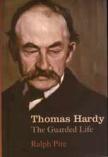Behind the Serene Public Image'
Well aware of Hardy’s compulsive tendency to present a public face quite different from the private one, Pite reveals a shy, idealistic and strongly erotic man raised in an almost feudal country society he still loved at a time when the rest of England had moved into the Industrial Revolution. He was a man torn between two worlds, a fact made startlingly visible after his death when his heart was buried in Dorset while his ashes lay in Westminster Abbey.
Much of the interest in Hardy today stems from his deep rootedness in Dorset, still one of the most remote counties in England. In this age of tourism, the county in which he set his stories, renaming it Wessex, is an important destination for literary travelers. Guide maps relate the characters and events of his novels to its still-rural roads and the villages he renamed. No one is better able to explore the importance of place in Hardy’s work than Pite, the author of Hardy’s Geography: Wessex and the Regional Novel.
The author, who teaches English at Cardiff University in Wales, starts off by guiding us up the lane to the large, thatched-roof Hardy cottage, pointing out the slippery parts and the dark overhanging trees. He describes the different directions the 9-year-old boy could take on his three-mile walk to school, suggesting that you can feel Hardy’s life beginning around you, the great evolving web of his endeavors and relationships spreading out over this particular piece of land.
Recording the writer’s constant moves between his beloved countryside and the civilized worlds of London and Europe, Pite reveals the deep split in Hardy between traditional and progressive behavior. The greatest difficulty Hardy poses to biographers is the fact that he was such a loner, and that the meaning of his most important relationships and ideas rested in his secretive interior life. Pite believes that the repressions ingrained in this oldest son by his ambitious and unaffectionate family were the chief cause of a lack of fulfillment in his private, emotional life. This in turn led to the loss of faith and pessimism found in both his novels and poetry. Not only did his family push him into architecture, never accepting him as a writer, but they were permanently hostile to his suitable and supportive wife, Emma.
As he grew older, Hardy became exceptionally vulnerable to the charms of younger society women, and was deeply wounded when they used or rejected him. (The most significant was on religious grounds.) His resentment of Florence Henniker, a faithful friend of the couple who turned down his pleas for an adulterous relationship, appears to have been the original moving force behind Jude. But Pite cites documents showing that Jude’s attacks on church and social convention were directed not only at Hardy’s resistant lover but also at his faithful, believing wife. One tragic bit of black humor that illustrates his extreme sensitivity was his habit, late in life, as he planned his grave between his two wives (Emma died in 1912, and he married his secretary in 1914) of changing the number of inches between them and him, moving one closer or farther away depending on his sense of her affection. Apparently he was a tightwad as well, not tipping servants, and famous for the lectures he gave them for putting too many coals on the fire.
Still, there is much evidence of his love for both wives and theirs for him, as well as his often charming and amusing behavior. His personality seems as divided as his love of place. While taking us on every household move with Thomas and Emma Hardy, and monitoring the constant emotional ups and downs of their long marriage, Pite includes much local British lore, the history of church musiclike his father, Hardy was a fine violin playerand the history of the railroad, whose failure to connect with Dorset left it a permanent backwater.
Best of all, Pite mines the writer’s novels and poetry with great sensitivity, using them to illuminate Hardy’s life at every stage. After the criticism Hardy received for Jude, even though it was a bestseller, he gave up novels and spent the last 30 years of his life writing poems. Many reveal his gloom and despair, but The Darkling Thrush, one of the most moving, conveys a sign of the hope he managed to preserve. Most interesting, perhaps, are those grieving over his memories of Emmafor instance, After a Journey or At Castle Boterel from Poems of 1912-13that show both the strength of his love and remorse for his own behavior.
Pite is thorough in his research, if somewhat old-fashioned in his style; most college students would find Thomas Hardy a bit tedious. But serious readers seeking to understand how Thomas Hardy’s life provides the ideas and passions that fill his novels and poems will find the book illuminating. It should lead them to reread the works themselves.
This article also appeared in print, under the headline “Behind the Serene Public Image',” in the April 30, 2007, issue.








